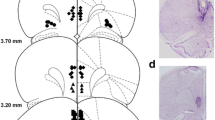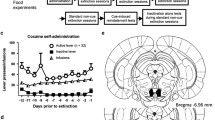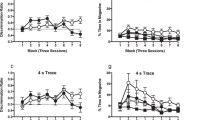Summary
Intracerebral injections of ibotenate were used to produce, in rats, extensive cell loss in the hippocampus and dentate gyrus (complete hippocampal, CH), in the CH plus subiculum (SUB + CH), or in the subiculum plus entorhinal cortex (SUB + EC). These rats and sham-operated controls were trained to run in a straight alley for food reward delivered on a continuous (CR) or partial (PR) reinforcement schedule. In controls PR training gave rise to the well-known partial reinforcement extinction effect (PREE), i.e., greater resistance to extinction than that observed in CR-trained animals. Previous work had shown that large aspiration lesions of the hippocampal formation eliminate the PREE by increasing resistance to extinction in CR-trained animals and decreasing resistance to extinction in PR-trained animals. In the present experiments the PREE survived CH lesions, which increased resistance to extinction in both CR and PR training conditions; these effects were observed in the start and run (but not goal) sections of the alley. In contrast, subicular cell loss (in both SUB + CH and SUB + EC groups) abolished the PREE (but in the goal section only) by increasing resistance to extinction in the CR condition and decreasing resistance to extinction in the PR condition. In addition, some of the effects of PR training on start and run speeds during acquisition were altered by the CH and SUB + CH lesions. These results confirm previous data showing that the hippocampal formation plays a role in mediating the behavioural effects of PR training, but require modification of the model previously proposed to account for these data.
Similar content being viewed by others

References
Andersen P, Bland BH, Dudar JD (1973) Organization of the hippocampal output. Exp Brain Res 17: 152–168
Amsel A, Rashotte ME, MacKinnon JR (1966) Partial reinforcement effects within subject and between subjects. Psychol Monog 80: 1–39 (whole no 628)
Black AH, Nadel L, O Keefe J (1977) Hippocampal function in avoidance learning and punishment. Psychol Bull 84: 1107–1129
Brunner RL, Haggbloom SJ, Gassara RA (1974) Effects of hippocampal X-irradiation produced granule-cell agenesis on instrumental runway performance in rats. Physiol Behav 13: 485–494
Feldon J, Gray JA (1979a) Effects of medial and lateral septal lesions on the partial reinforcement extinction effect at one trial a day. Q J Exp Psychol 34: 653–674
Feldon J, Gray JA (1979b) Effects of medial and lateral septal lesions on the partial reinforcement extinction effect at short inter-trial intervals. Q J Exp Psychol 31: 675–690
Feldon J, Gray JA (1981) The partial reinforcement extinction effect after treatment with chlordiazepoxide. Psychopharmacology 73: 269–275
Feldon J, Guillamon A, Gray JA, De Wit H, McNaughton N (1979) Sodium amylobarbitone and responses to nonreward. Q J Exp Psychol 31: 19–50
Feldon J, Rawlins JNP, Gray JA (1985) Fornix-fimbria section and the partial reinforcement extinction effect. Exp Brain Res 58: 435–439
Fink RP, Heimer L (1967) Two methods for selective sliver impregnation of degenerating axons and their synaptic endings in the CNS. Brain Res 4: 369–374
Goodrich KP (1959) Performance in different segments of an instrumental response chain as a function of reinforcement schedule. J Exp Psychol 57: 57–63
Gray JA (1982) The neuropsychology of anxiety: an enquiry into the functions of the septo-hippocampal system. Oxford University Press, Oxford
Gray JA, Feldon J, Rawlins JNP, Owen S, McNaughton N (1978) The role of the septo-hippocampal system and its noradrenergic afferents in behavioural responses to nonreward. In: Elliott K, Whelan J (eds) Functions of the septo-hippocampal system. Ciba Foundation Symposium No 58 (New Series) Elsevier, Amsterdam, pp 275–300
Haggard DF (1959) Acquisition of a simple running response as a function of partial and continuous schedules of reinforcement. Psychol Rep 9: 11–18
Henke PG (1974) Persistence of runway performance after septal lesions in rats. J Comp Physiol Psychol 86: 760–767
Henke PG (1974) Dissociation of the frustration effect and the partial reinforcement extinction effect after limbic lesions in rats. J Comp Physiol Psychol 91: 1032–1038
Jarrad LE (1986) Selective hippocampal lesions and behaviour implications for current research and theorizing. In: Isaacson RL, Pribram K (eds) The hippocampus. Plenum Press, New York (in press)
Kohler C, Schwarcz R (1983) Comparison of ibotenate and kainate neurotoxicity in the rat brain: a histological study. Neuroscience 8: 819–835
O Keefe J, Nadel L (1978) The hippocampus as a cognitive map. Clarendon Press, Oxford
Owen S, Boarder M, Gray JA, Fillenz M (1982) Acquisition and extinction of continuously and partially reinforced running in rats with lesions of the dorsal noradrenergic bundle. Behav Brain Res 5: 11–41
Paxinos G, Watson C (1982) The rat brain in stereotaxic coordinates. Academic Press, Sydney
Rawlins JNP, Feldon J, Gray JA (1980) The effects of hippocampectomy and of fimbria section upon the partial reinforcement extinction effect in rats. Exp Brain Res 38: 273–283
Rawlins JNP, Feldon J, Ursin H, Gray JA (1985) Resistance to extinction after schedules of partial delay or partial reinforcement in rats with hippocampal lesion. Exp Brain Res 59: 273–281
Sinden JD, Rawlins JNP, Gray JA, Jarrard LE (1986) Selective cytotoxic lesions of the hippocampal formation and DRL performance in rats. Behav Neurosci (in press)
Swanson LW (1978) The anatomical organization of septo-hippocampal projections. In: Elliot K, Whelan J (eds) Functions of the septo-hippocampal system. Ciba Foundation Symposium 58 (New Series) pp 25–43
Author information
Authors and Affiliations
Rights and permissions
About this article
Cite this article
Jarrard, L.E., Feldon, J., Rawlins, J.N.P. et al. The effects of intrahippocampal ibotenate on resistance to extinction after continuous or partial reinforcement. Exp Brain Res 61, 519–530 (1986). https://doi.org/10.1007/BF00237577
Received:
Accepted:
Issue Date:
DOI: https://doi.org/10.1007/BF00237577



